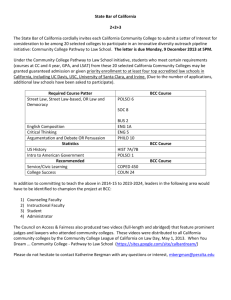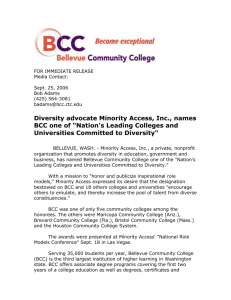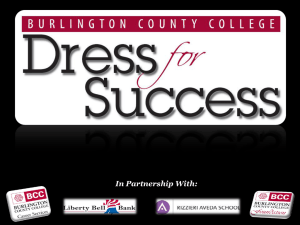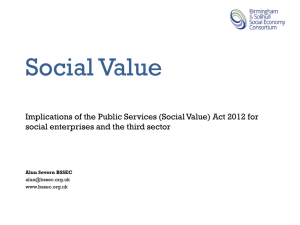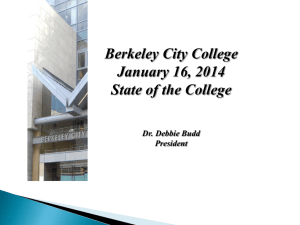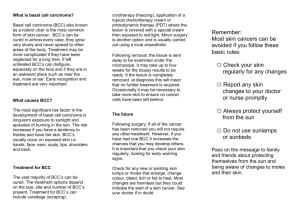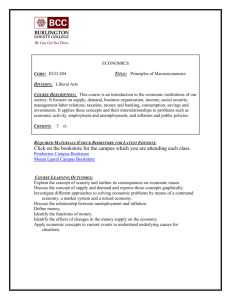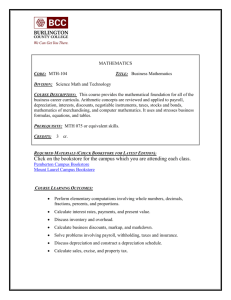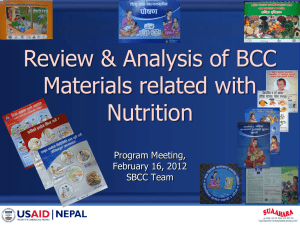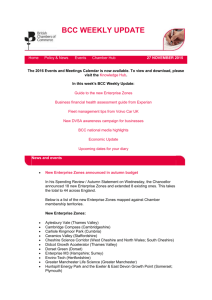LC121113 – BCC Goals-and student success match.12.10.13
advertisement
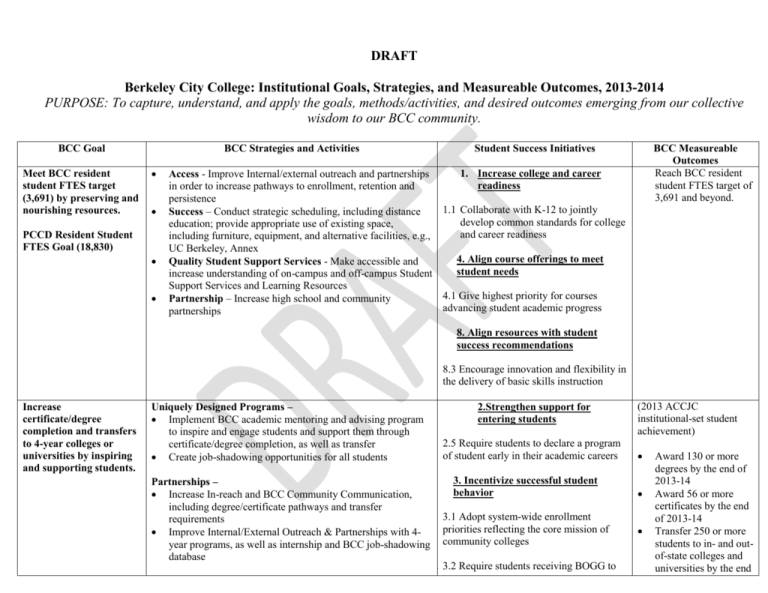
DRAFT Berkeley City College: Institutional Goals, Strategies, and Measureable Outcomes, 2013-2014 PURPOSE: To capture, understand, and apply the goals, methods/activities, and desired outcomes emerging from our collective wisdom to our BCC community. BCC Goal Meet BCC resident student FTES target (3,691) by preserving and nourishing resources. BCC Strategies and Activities PCCD Resident Student FTES Goal (18,830) Student Success Initiatives BCC Measureable Outcomes Reach BCC resident student FTES target of 3,691 and beyond. 1. Increase college and career Access - Improve Internal/external outreach and partnerships readiness in order to increase pathways to enrollment, retention and persistence 1.1 Collaborate with K-12 to jointly Success – Conduct strategic scheduling, including distance develop common standards for college education; provide appropriate use of existing space, and career readiness including furniture, equipment, and alternative facilities, e.g., UC Berkeley, Annex 4. Align course offerings to meet Quality Student Support Services - Make accessible and student needs increase understanding of on-campus and off-campus Student Support Services and Learning Resources 4.1 Give highest priority for courses Partnership – Increase high school and community advancing student academic progress partnerships 8. Align resources with student success recommendations 8.3 Encourage innovation and flexibility in the delivery of basic skills instruction Increase certificate/degree completion and transfers to 4-year colleges or universities by inspiring and supporting students. Uniquely Designed Programs – Implement BCC academic mentoring and advising program to inspire and engage students and support them through certificate/degree completion, as well as transfer Create job-shadowing opportunities for all students Partnerships – Increase In-reach and BCC Community Communication, including degree/certificate pathways and transfer 2.1 requirements Improve Internal/External Outreach & Partnerships with 4year programs, as well as internship and BCC job-shadowing database 2.2 2.Strengthen support for entering students 2.5 Require students to declare a program of student early in their academic careers 3. Incentivize successful student behavior 3.1 Adopt system-wide enrollment priorities reflecting the core mission of community colleges 3.2 Require students receiving BOGG to (2013 ACCJC institutional-set student achievement) Award 130 or more degrees by the end of 2013-14 Award 56 or more certificates by the end of 2013-14 Transfer 250 or more students to in- and outof-state colleges and universities by the end meet various conditions and requirements Quality Student Support Services – Make accessible and increase understanding of on-campus 2.3 3.3 Provide students the opportunity to and off-campus Student Support Services and Learning consider full time Resources, especially those needed for completion and transfer. 6. Revitalize and re-envision professional development Equity – Facilitate and enhance faculty, student, & staff 6.1 Create a continuum of mandatory understanding of ADTs (AA-T and AS-T) professional development opportunities Maintain a master calendar and up-to-date web information regarding academic deadlines, events, student support, and 6.2 Direct professional development learning resources resources toward improving basic skills instruction and support services Improve career and college preparation progress and success rates (successfully transition students from basic skills to college-level, as well as CTE/ career) Ensure BCC programs and services reach Support Quality Instruction Provide Professional Development to better prepare all professionals (staff, faculty, student leaders, administration) to help students understand pathways, as well as completion2.4 of degrees/certificates in a timely manner Implement an academic advising program (based on CCSSE2.5 results and recommendation from Department Chairs’ Council) Share and implement contextualized learning, applied and service learning, including CTE, soft skills, college and 2.6 career readiness, and internships Ensure adequate curriculum, including integrative assignments across classes to connect/support students and instructors 2.7 Quality Student Support Services – Make accessible and increase understanding of on-campus and off-campus Student Support Services and Learning Resources, especially those needed for CTE completion and employment Increase hours of availability for computer labs and library to accommodate students who need early morning, evening, and Saturday hours (based on CCSSE results and library assessment) Institutional Leadership and Governance – Engage BCC community in understanding Shared 2.Strengthen support for entering students 2.1 Develop and implement common centralized diagnostic assessments of 2013-14 (2013 AACJC institutional-set student achievement) 2.2 Require students to participate in diagnostic assessment, orientation and the develop of an education plan 2.3 Develop and use technology application to better guide students in education processes 2.4 Require students showing a lack of college readiness to participate in support resources Reach student course completion rate of 64% or higher for all courses, especially for basic skills and CTE courses Reach student retention percentage of 50% or higher for all courses, especially for basic skills and CTE courses 3. Incentivize successful student behavior 3.4 Require students to begin addressing basic skills deficiencies in their first year 7. Enable efficient state-/districtcollege-wide leadership and increase Complete AACJC Institutional Self- sustainable, continuous quality improvement level Governance, including roles, responsibilities, and information flow Conduct effective Institutional Self-Evaluation with collegewide participation Expand the Use of Educational Technology – Provide cross-college training and support in district, state, and federal data tools Institutional Effectiveness – Engage in Assessment work for Service Areas, including Office of Instruction, Special Projects, and Student Services, including Veterans’ Services, Campus Life and Student Affairs Complete and apply ILOs, assessment, CCSSE, and other assessment tools to increase student success Collaborate to ensure Fiscal Stability Fiscal Oversight - Implement fully funded BAM; increase flexibility of funds due to additional revenue streams. Budget to Improve Student Success - Secure grant to continue Student Services-Instruction collaboration initiated under Title III Evaluation according to timeline. coordination among colleges/departments 7.1 Develop and support a strong community college system office 7.2 Set local student success goals consistent with statewide/district goals Reaffirm full Accreditation in Spring 2015 Ensure data-driven program improvement process and integrate planning into resource development and allocation All course, program, and ILO assessments are completed, as scheduled on the published timeline Stay within adopted 2013-14 annual budget Develop and secure additional revenue streams, i.e. nonresident enrollment, community partnerships, industry relationships, etc. 7.3 Implement a student success scorecard 7.4 Develop and support a longitudinal student record system 8. Align resources with student success recommendations 8.1 Encourage categorical program streamlining and cooperation 8.2 Invest in the new Student Support initiative
